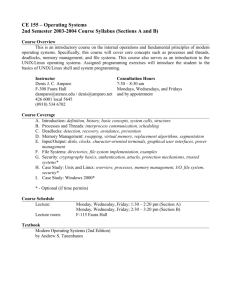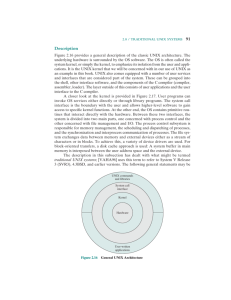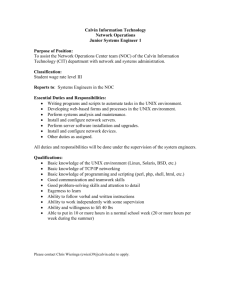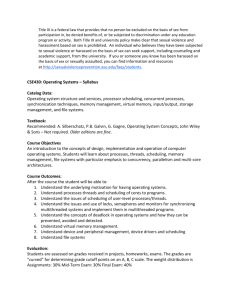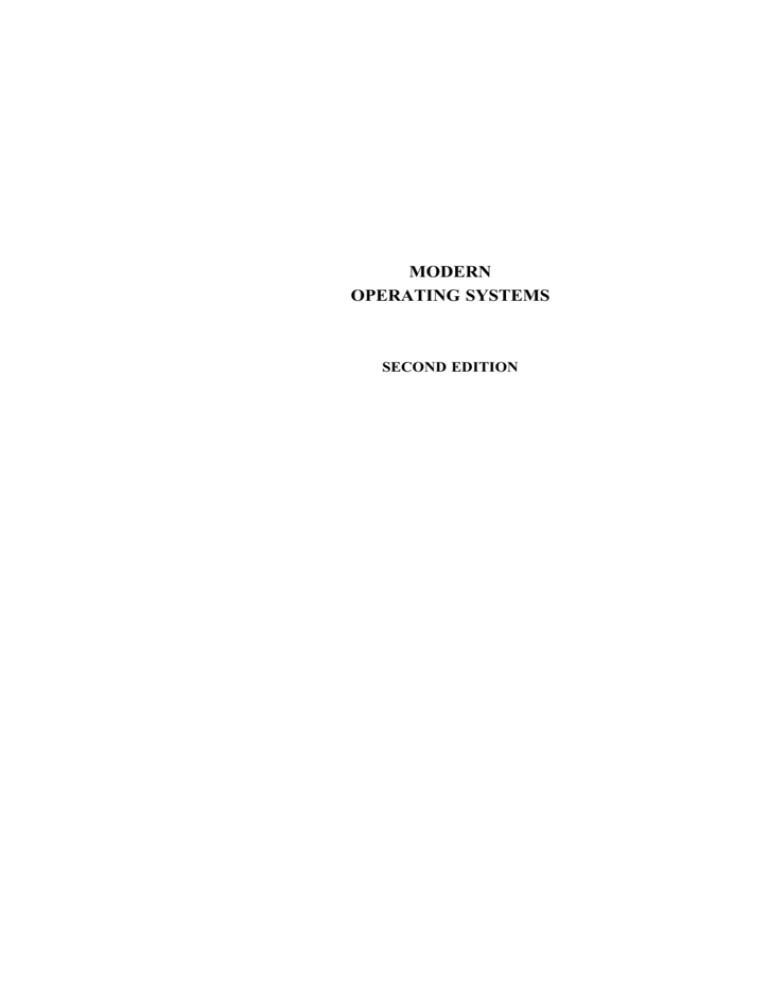
MODERN
OPERATING SYSTEMS
SECOND EDITION
Other bestselling titles by Andrew S. Tanenbaum
Structured Computer Organization, 4th edition
This widely-read classic, now in its fourth edition, provides the ideal introduction
to computer architecture. It covers the topic in an easy-to-understand way, bottom up. There is a chapter on digital logic for beginners, followed by chapters on
microarchitecture, the instruction set architecture level, operating systems, assembly language, and parallel computer architectures.
Computer Networks, 3rd edition
This widely-read classic, now in its third edition, provides the ideal introduction
to today’s and tomorrow’s networks. It explains in detail how modern networks
are structured. Starting with the physical layer and working up to the application
layer, the book covers a vast number of important topics, including wireless communication, fiber optics, data link protocols, Ethernet, routing algorithms, network
performance, security, DNS, electronic mail, USENET news, the World Wide
Web, and multimedia. The book has especially thorough coverage of TCP/IP and
the Internet.
Operating Systems: Design and Implementation, 2nd edition
This popular text on operating systems is the only book covering both the principles of operating systems and their application to a real system. All the traditional
operating systems topics are covered in detail. In addition, the principles are carefully illustrated with MINIX, a free POSIX-based UNIX-like operating system for
personal computers. Each book contains a free CD-ROM containing the complete
MINIX system, including all the source code. The source code is listed in an
appendix to the book amd explained in detail in the text.
Distributed Operating Systems
This text covers the fundamental concepts of distributed operating systems. Key
topics include communication and synchronization, processes and processors, distributed shared memory, distributed file systems, and distributed real-time systems. The principles are illustrated using four chapter-long examples.
MODERN
OPERATING SYSTEMS
SECOND EDITION
ANDREW S. TANENBAUM
Vrije Universiteit
Amsterdam, The Netherlands
PRENTICE HALL
UPPER SADDLE RIVER, NEW JERSEY 07458
Library of Congress Cataloging in Publication Data
TANENBAUM, ANDREW, S. (date)
Structured Computer Organization
Bibliography
1. Electronic digital computers−Programming
I. Title
QA76.6.T38
001.6′42
74-30322
ISBN 0-13-000000-0
© 2001 by Prentice-Hall, Inc., Upper Saddle River, NJ
All rights reserved. No part of this book
may be reproduced in any form or by any means
without permission in writing from the publisher.
10 9 8 7 6 5 4 3 2 1
Printed in the United States of America
PRENTICE-HALL INTERNATIONAL, INC., London
PRENTICE-HALL OF AUSTRALIA PTY. LTD., Sydney
EDITORA PRENTICE-HALL DO BRAZIL, LTDA., Rio de Janeiro
PRENTICE-HALL OF CANADA, LTD., Toronto
PRENTICE-HALL OF INDIA PRIVATE LTD., New Delhi
PRENTICE-HALL OF JAPAN, INC., Tokyo
PRENTICE-HALL OF SOUTHEAST ASIA PTE. LTD., Singapore
WHITEHALL BOOKS LTD., Wellington, New Zealand
To Suzanne, Barbara, Marvin, and the memory of Bram and Sweetie π
CONTENTS
xvi
PREFACE
1
1
INTRODUCTION
1.1.
WHAT IS AN OPERATING SYSTEM? 3
1.1.1. The Operating System as an Extended Machine 3
1.1.2. The Operating System as a Resource Manager 5
1.2.
HISTORY OF OPERATING SYSTEMS 6
1.2.1. The First Generation (1945-55) 6
1.2.2. The Second Generation (1955-65) 7
1.2.3. The Third Generation (1965-1980) 9
1.2.4. The Fourth Generation (1980-Present) 13
1.2.5. Ontogeny Recapitulates Phylogeny 16
1.3.
THE OPERATING SYSTEM ZOO 18
1.3.1. Mainframe Operating Systems 18
1.3.2. Server Operating Systems 19
1.3.3. Multiprocessor Operating Systems 19
1.3.4. Personal Computer Operating Systems 19
1.3.5. Real-Time Operating Systems 19
1.3.6. Embedded Operating Systems 20
1.3.7. Smart Card Operating Systems 20
vii
viii
CONTENTS
1.4.
COMPUTER HARDWARE REVIEW
1.4.1. Processors 21
1.4.2. Memory 23
1.4.3. I/O Devices 28
1.4.4. Buses 31
1.5.
OPERATING SYSTEM CONCEPTS
1.5.1. Processes 34
1.5.2. Deadlocks 36
1.5.3. Memory Management 37
1.5.4. Input/Output 38
1.5.5. Files 38
1.5.6. Security 41
1.5.7. The Shell 41
1.5.8. Recycling of Concepts 43
1.6.
SYSTEM CALLS 44
1.6.1. System Calls for Process Management 48
1.6.2. System Calls for File Management 50
1.6.3. System Calls for Directory Management 51
1.6.4. Miscellaneous System Calls 53
1.6.5. The Windows Win32 API 53
1.7.
OPERATING SYSTEM STRUCTURE
1.7.1. Monolithic Systems 56
1.7.2. Layered Systems 57
1.7.3. Virtual Machines 59
1.7.4. Exokernels 61
1.7.5. Client-Server Model 61
1.8.
RESEARCH ON OPERATING SYSTEMS 63
1.9.
OUTLINE OF THE REST OF THIS BOOK
1.10. METRIC UNITS 66
1.11. SUMMARY
67
20
34
56
65
CONTENTS
2
PROCESSES AND THREADS
2.1.
PROCESSES 71
2.1.1. The Process Model 72
2.1.2. Process Creation 73
2.1.3. Process Termination 75
2.1.4. Process Hierarchies 76
2.1.5. Process States 77
2.1.6. Implementation of Processes 79
2.2.
THREADS 81
2.2.1. The Thread Model 81
2.2.2. Thread Usage 85
2.2.3. Implementing Threads in User Space 90
2.2.4. Implementing Threads in the Kernel 93
2.2.5. Hybrid Implementations 94
2.2.6. Scheduler Activations 94
2.2.7. Pop-Up Threads 96
2.2.8. Making Single-Threaded Code Multithreaded 97
2.3.
INTERPROCESS COMMUNICATION 100
2.3.1. Race Conditions 100
2.3.2. Critical Regions 102
2.3.3. Mutual Exclusion with Busy Waiting 103
2.3.4. Sleep and Wakeup 108
2.3.5. Semaphores 110
2.3.6. Mutexes 113
2.3.7. Monitors 115
2.3.8. Message Passing 119
2.3.9. Barriers 123
2.4.
CLASSICAL IPC PROBLEMS 124
2.4.1. The Dining Philosophers Problem 125
2.4.2. The Readers and Writers Problem 128
2.4.3. The Sleeping Barber Problem 129
2.5.
SCHEDULING 132
2.5.1. Introduction to Scheduling 132
2.5.2. Scheduling in Batch Systems 138
2.5.3. Scheduling in Interactive Systems 142
2.5.4. Scheduling in Real-Time Systems 148
2.5.5. Policy versus Mechanism 149
2.5.6. Thread Scheduling 150
ix
71
x
3
CONTENTS
2.6.
RESEARCH ON PROCESSES AND THREADS 151
2.7.
SUMMARY 152
DEADLOCKS
159
3.1.
RESOURCES 160
3.1.1. Preemptable and Nonpreemptable Resources 160
3.1.2. Resource Acquisition 161
3.2.
INTRODUCTION TO DEADLOCKS 163
3.2.1. Conditions for Deadlock 164
3.2.2. Deadlock Modeling 164
3.3.
THE OSTRICH ALGORITHM 167
3.4.
DEADLOCK DETECTION AND RECOVERY 168
3.4.1. Deadlock Detection with One Resource of Each Type 168
3.4.2. Deadlock Detection with Multiple Resource of Each Type 171
3.4.3. Recovery from Deadlock 173
3.5.
DEADLOCK AVOIDANCE 175
3.5.1. Resource Trajectories 175
3.5.2. Safe and Unsafe States 176
3.5.3. The Banker’s Algorithm for a Single Resource 178
3.5.4. The Banker’s Algorithm for Multiple Resources 179
3.6.
DEADLOCK PREVENTION 180
3.6.1. Attacking the Mutual Exclusion Condition 180
3.6.2. Attacking the Hold and Wait Condition 181
3.6.3. Attacking the No Preemption Condition 182
3.6.4. Attacking the Circular Wait Condition 182
3.7.
OTHER ISSUES 183
3.7.1. Two-Phase Locking 183
3.7.2. Nonresource Deadlocks 184
3.7.3. Starvation 184
3.8.
RESEARCH ON DEADLOCKS 185
3.9.
SUMMARY 185
xi
CONTENTS
4
MEMORY MANAGEMENT
189
4.1.
BASIC MEMORY MANAGEMENT 190
4.1.1. Monoprogramming without Swapping or Paging 190
4.1.2. Multiprogramming with Fixed Partitions 191
4.1.3. Modeling Multiprogramming 192
4.1.4. Analysis of Multiprogramming System Performance 194
4.1.5. Relocation and Protection 194
4.2.
SWAPPING 196
4.2.1. Memory Management with Bitmaps 199
4.2.2. Memory Management with Linked Lists 200
4.3.
VIRTUAL MEMORY 202
4.3.1. Paging 202
4.3.2. Page Tables 205
4.3.3. TLBs—Translation Lookaside Buffers 211
4.3.4. Inverted Page Tables 213
4.4.
PAGE REPLACEMENT ALGORITHMS 214
4.4.1. The Optimal Page Replacement Algorithm 215
4.4.2. The Not Recently Used Page Replacement Algorithm 216
4.4.3. The First-In, First-Out 217
4.4.4. The Second Chance Page Replacement Algorithm 217
4.4.5. The Clock Page Replacement Algorithm 218
4.4.6. The Least Recently Used 218
4.4.7. Simulating LRU in Software 220
4.4.8. The Working Set Page Replacement Algorithm 222
4.4.9. The WSClock Page Replacement Algorithm 225
4.4.:. Summary of Page Replacement Algorithms 227
4.5.
MODELING PAGE REPLACEMENT ALGORITHMS 228
4.5.1. Belady’s Anomaly 229
4.5.2. Stack Algorithms 229
4.5.3. The Distance String 232
4.5.4. Predicting Page Fault Rates 233
4.6.
DESIGN ISSUES FOR PAGING SYSTEMS 234
4.6.1. Local versus Global Allocation Policies 234
4.6.2. Load Control 236
4.6.3. Page Size 237
4.6.4. Separate Instruction and Data Spaces 239
xii
CONTENTS
4.6.5. Shared Pages 239
4.6.6. Cleaning Policy 241
4.6.7. Virtual Memory Interface 241
4.7.
IMPLEMENTATION ISSUES 242
4.7.1. Operating System Involvement with Paging 242
4.7.2. Page Fault Handling 243
4.7.3. Instruction Backup 244
4.7.4. Locking Pages in Memory 246
4.7.5. Backing Store 246
4.7.6. Separation of Policy and Mechanism 247
4.8.
SEGMENTATION 249
4.8.1. Implementation of Pure Segmentation 253
4.8.2. Segmentation with Paging: MULTICS 254
4.8.3. Segmentation with Paging: The Intel Pentium 257
4.9.
RESEARCH ON MEMORY MANAGEMENT 262
4.10. SUMMARY 262
5
INPUT/OUTPUT
5.1.
PRINCIPLES OF I/O HARDWARE 269
5.1.1. I/O Devices 270
5.1.2. Device Controllers 271
5.1.3. Memory-Mapped I/O 272
5.1.4. Direct Memory Access 276
5.1.5. Interrupts Revisited 279
5.2.
PRINCIPLES OF I/O SOFTWARE 282
5.2.1. Goals of the I/O Software 283
5.2.2. Programmed I/O 284
5.2.3. Interrupt-Driven I/O 286
5.2.4. I/O Using DMA 287
5.3.
I/O SOFTWARE LAYERS 287
5.3.1. Interrupt Handlers 287
5.3.2. Device Drivers 289
269
CONTENTS
xiii
5.3.3. Device-Independent I/O Software 292
5.3.4. User-Space I/O Software 298
5.4.
DISKS 300
5.4.1. Disk Hardware 300
5.4.2. Disk Formatting 315
5.4.3. Disk Arm Scheduling Algorithms 318
5.4.4. Error Handling 322
5.4.5. Stable Storage 324
5.5.
CLOCKS 327
5.5.1. Clock Hardware 328
5.5.2. Clock Software 329
5.5.3. Soft Timers 332
5.6.
CHARACTER-ORIENTED TERMINALS 333
5.6.1. RS-232 Terminal Hardware 334
5.6.2. Input Software 336
5.6.3. Output Software 341
5.7.
GRAPHICAL USER INTERFACES 342
5.7.1. Personal Computer Keyboard, Mouse, and Display Hardware 343
5.7.2. Input Software 347
5.7.3. Output Software for Windows 347
5.8.
NETWORK TERMINALS 355
5.8.1. The X Window System 356
5.8.2. The SLIM Network Terminal 360
5.9.
POWER MANAGEMENT 363
5.9.1. Hardware Issues 364
5.9.2. Operating System Issues 365
5.9.3. Degraded Operation 370
5.10. RESEARCH ON INPUT/OUTPUT 371
5.11. SUMMARY 372
xiv
6
CONTENTS
FILE SYSTEMS
6.1.
FILES 380
6.1.1. File Naming 380
6.1.2. File Structure 382
6.1.3. File Types 383
6.1.4. File Access 385
6.1.5. File Attributes 386
6.1.6. File Operations 387
6.1.7. An Example Program Using File System Calls 389
6.1.8. Memory-Mapped Files 391
6.2.
DIRECTORIES 393
6.2.1. Single-Level Directory Systems 393
6.2.2. Two-level Directory Systems 394
6.2.3. Hierarchical Directory Systems 395
6.2.4. Path Names 395
6.2.5. Directory Operations 398
6.3.
FILE SYSTEM IMPLEMENTATION 399
6.3.1. File System Layout 399
6.3.2. Implementing Files 400
6.3.3. Implementing Directories 405
6.3.4. Shared Files 408
6.3.5. Disk Space Management 410
6.3.6. File System Reliability 416
6.3.7. File System Performance 424
6.3.8. Log-Structured File Systems 428
6.4.
EXAMPLE FILE SYSTEMS 430
6.4.1. CD-ROM File Systems 430
6.4.2. The CP/M File System 435
6.4.3. The MS-DOS File System 438
6.4.4. The Windows 98 File System 442
6.4.5. The UNIX V7 File System 445
6.5.
RESEARCH ON FILE SYSTEMS 448
6.6.
SUMMARY 448
379
CONTENTS
7
MULTIMEDIA OPERATING SYSTEMS
7.1.
INTRODUCTION TO MULTIMEDIA 454
7.2.
MULTIMEDIA FILES 458
7.2.1. Audio Encoding 459
7.2.2. Video Encoding 461
7.3.
VIDEO COMPRESSION 463
7.3.1. The JPEG Standard 464
7.3.2. The MPEG Standard 467
7.4.
MULTIMEDIA PROCESS SCHEDULING 469
7.4.1. Scheduling Homogeneous Processes 469
7.4.2. General Real-Time Scheduling 470
7.4.3. Rate Monotonic Scheduling 472
7.4.4. Earliest Deadline First Scheduling 473
7.5.
MULTIMEDIA FILE SYSTEM PARADIGMS 475
7.5.1. VCR Control Functions 476
7.5.2. Near Video on Demand 478
7.5.3. Near Video on Demand with VCR Functions 479
7.6.
FILE PLACEMENT 481
7.6.1. Placing a File on a Single Disk 481
7.6.2. Two Alternative File Organization Strategies 482
7.6.3. Placing Files for Near Video on Demand 486
7.6.4. Placing Multiple Files on a Single Disk 487
7.6.5. Placing Files on Multiple Disks 490
7.7.
CACHING 492
7.7.1. Block Caching 492
7.7.2. File Caching 494
7.8.
DISK SCHEDULING FOR MULTIMEDIA 494
7.8.1. Static Disk Scheduling 495
7.8.2. Dynamic Disk Scheduling 496
7.9.
RESEARCH ON MULTIMEDIA 498
7.10. SUMMARY 499
xv
453
xvi
8
9
CONTENTS
MULTIPLE PROCESSOR SYSTEMS
8.1.
MULTIPROCESSORS 506
8.1.1. Multiprocessor Hardware 506
8.1.2. Multiprocessor Operating System Types 513
8.1.3. Multiprocessor Synchronization 516
8.1.4. Multiprocessor Scheduling 521
8.2.
MULTICOMPUTERS 526
8.2.1. Multicomputer Hardware 527
8.2.2. Low-Level Communication Software 531
8.2.3. User-Level Communication Software 534
8.2.4. Remote Procedure Call 537
8.2.5. Distributed Shared Memory 540
8.2.6. Multicomputer Scheduling 544
8.2.7. Load Balancing 545
8.3.
DISTRIBUTED SYSTEMS 549
8.3.1. Network Hardware 551
8.3.2. Network Services and Protocols 553
8.3.3. Document-Based Middleware 558
8.3.4. File System-Based Middleware 559
8.3.5. Shared Object-Based Middleware 565
8.3.6. Coordination-Based Middleware 572
8.4.
RESEARCH ON MULTIPLE PROCESSOR SYSTEMS 577
8.5.
SUMMARY 577
SECURITY
9.1.
THE SECURITY ENVIRONMENT 584
9.1.1. Threats 584
9.1.2. Intruders 585
9.1.3. Accidental Data Loss 586
9.2.
BASICS OF CRYPTOGRAPHY 587
9.2.1. Secret-Key Cryptography 588
9.2.2. Public-Key Cryptography 588
503
583
CONTENTS
9.2.3. One-Way Functions 589
9.2.4. Digital Signatures 590
9.3.
USER AUTHENTICATION 591
9.3.1. Authentication Using Passwords 592
9.3.2. Authentication Using a Physical Object 601
9.3.3. Authentication Using Biometrics 603
9.3.4. Countermeasures 606
9.4.
ATTACKS FROM INSIDE THE SYSTEM 606
9.4.1. Trojan Horses 607
9.4.2. Login Spoofing 608
9.4.3. Logic Bombs 609
9.4.4. Trap Doors 610
9.4.5. Buffer Overflow 610
9.4.6. Generic Security Attacks 613
9.4.7. Famous Security Flaws 614
9.4.8. Design Principles for Security 616
9.5.
ATTACKS FROM OUTSIDE THE SYSTEM 617
9.5.1. Virus Damage Scenarios 618
9.5.2. How Viruses Work 619
9.5.3. How Viruses Spread 626
9.5.4. Antivirus and Anti-Antivirus Techniques 628
9.5.5. The Internet Worm 635
9.5.6. Mobile Code 637
9.5.7. Java Security 642
9.6.
PROTECTION MECHANISMS 645
9.6.1. Protection Domains 645
9.6.2. Access Control Lists 647
9.6.3. Capabilities 650
9.7.
TRUSTED SYSTEMS 653
9.7.1. Trusted Computing Base 654
9.7.2. Formal Models of Secure Systems 655
9.7.3. Multilevel Security 657
9.7.4. Orange Book Security 659
9.7.5. Covert Channels 661
9.8.
RESEARCH ON SECURITY 665
9.9.
SUMMARY 666
xvii
xviii
10
CONTENTS
CASE STUDY 1: UNIX AND LINUX
10.1. HISTORY OF UNIX 672
10.1.1. UNICS 672
10.1.2. PDP-11 UNIX 673
10.1.3. Portable UNIX 674
10.1.4. Berkeley UNIX 675
10.1.5. Standard UNIX 676
10.1.6. MINIX 677
10.1.7. Linux 678
10.2. OVERVIEW OF UNIX 681
10.2.1. UNIX Goals 681
10.2.2. Interfaces to UNIX 682
10.2.3. The UNIX Shell 683
10.2.4. UNIX Utility Programs 686
10.2.5. Kernel Structure 687
10.3. PROCESSES IN UNIX 690
10.3.1. Fundamental Concepts 690
10.3.2. Process Management System Calls in UNIX 692
10.3.3. Implementation of Processes in UNIX 699
10.3.4. Booting UNIX 708
10.4. MEMORY MANAGEMENT IN UNIX 710
10.4.1. Fundamental Concepts 711
10.4.2. Memory Management System Calls in UNIX 714
10.4.3. Implementation of Memory Management in UNIX 715
10.5. INPUT/OUTPUT IN UNIX 723
10.5.1. Fundamental Concepts 724
10.5.2. Input/Output System Calls in UNIX 726
10.5.3. Implementation of Input/Output in UNIX 727
10.5.4. Streams 730
10.6. THE UNIX FILE SYSTEM 732
10.6.1. Fundamental Concepts 732
10.6.2. File System Calls in UNIX 736
10.6.3. Implementation of the UNIX File System 740
10.6.4. NFS: The Network File System 747
671
CONTENTS
xix
10.7. SECURITY IN UNIX 753
10.7.1. Fundamental Concepts 753
10.7.2. Security System Calls in UNIX 755
10.7.3. Implementation of Security in UNIX 756
10.8. SUMMARY 757
11
CASE STUDY 2: WINDOWS 2000
763
11.1. HISTORY OF WINDOWS 2000 763
11.1.1. MS-DOS 763
11.1.2. Windows 95/98/Me 764
11.1.3. Windows NT 765
11.1.4. Windows 2000 767
11.2. PROGRAMMING WINDOWS 2000 771
11.2.1. The Win32 Application Programming Interface 772
11.2.2. The Registry 774
11.3. SYSTEM STRUCTURE 778
11.3.1. Operating System Structure 778
11.3.2. Implementation of Objects 787
11.3.3. Environment Subsystems 792
11.4. PROCESSES AND THREADS IN WINDOWS 2000 796
11.4.1. Fundamental Concepts 796
11.4.2. Job, Process, Thread and Fiber Management API Calls 799
11.4.3. Implementation of Processes and Threads 802
11.4.4. MS-DOS Emulation 809
11.4.5. Booting Windows 2000 820
11.5. MEMORY MANAGEMENT 811
11.5.1. Fundamental Concepts 812
11.5.2. Memory Management System Calls 816
11.5.3. Implementation of Memory Management 817
11.6. INPUT/OUTPUT IN WINDOWS 2000 824
11.6.1. Fundamental Concepts 824
11.6.2. Input/Output API Calls 825
11.6.3. Implementation of I/O 827
11.6.4. Device Drivers 827
xx
CONTENTS
11.7. THE WINDOWS 2000 FILE SYSTEM 830
11.7.1. Fundamental Concepts 830
11.7.2. File System API Calls in Windows 2000 831
11.7.3. Implementation of the Windows 2000 File System 833
11.8. SECURITY IN WINDOWS 2000 844
11.8.1. Fundamental Concepts 845
11.8.2. Security API Calls 847
11.8.3. Implementation of Security 848
11.9. CACHING IN WINDOWS 2000 849
11.10. SUMMARY 851
12
OPERATING SYSTEM DESIGN
12.1. THE NATURE OF THE DESIGN PROBLEM 856
12.1.1. Goals 856
12.1.2. Why is it Hard to Design an Operating Systems? 857
12.2. INTERFACE DESIGN 859
12.2.1. Guiding Principles 859
12.2.2. Paradigms 861
12.2.3. The System Call Interface 864
12.3 IMPLEMENTATION 867
12.3.1. System Structure 867
12.3.2. Mechanism versus Policy 870
12.3.3. Orthogonality 871
12.3.4. Naming 872
12.3.5. Binding Time 874
12.3.6. Static versus Dynamic Structures 875
12.3.7. Top-Down versus Bottom-Up Implementation 876
12.3.8. Useful Techniques 877
12.4. PERFORMANCE 882
12.4.1. Why are Operating Systems Slow? 882
12.4.2. What Should be Optimized? 883
12.4.3. Space-Time Trade-offs 884
12.4.4. Caching 887
855
CONTENTS
xxi
12.4.5. Hints 888
12.4.6. Exploiting Locality 888
12.4.7. Optimize the Common Case 889
12.5. PROJECT MANAGEMENT 889
12.5.1. The Mythical Man Month 890
12.5.2. Team Structure 891
12.5.3. The Role of Experience 893
12.5.4. No Silver Bullet 894
12.6. TRENDS IN OPERATING SYSTEM DESIGN 894
12.6.1. Large Address Space Operating Systems 894
12.6.2. Networking 895
12.6.3. Parallel and Distributed Systems 896
12.6.4. Multimedia 896
12.6.5. Battery-Powered Computers 896
12.6.6. Embedded Systems 897
12.7. SUMMARY 897
13
READING LIST AND BIBLIOGRAPHY
901
13.1. SUGGESTIONS FOR FURTHER READING 901
13.1.1. Introduction and General Works 902
13.1.2. Processes and Threads 902
13.1.3. Deadlocks 903
13.1.4. Memory Management 903
13.1.5. Input/Output 903
13.1.6. File Systems 904
13.1.7. Multimedia Operating Systems 905
13.1.8. Multiple Processor Systems 906
13.1.9. Security 907
13.1.10. UNIX and Linux 908
13.1.11. Windows 2000 909
13.1.12. Design Principles 910
13.2 ALPHABETICAL BIBLIOGRAPHY 911
INDEX
935
PREFACE
The world has changed a great deal since the first edition of this book appeared in 1992. Computer networks and distributed systems of all kinds have
become very common. Small children now roam the Internet, where previously
only computer professionals went. As a consequence, this book has changed a
great deal, too.
The most obvious change is that the first edition was about half on singleprocessor operating systems and half on distributed systems. I chose that format
in 1991 because few universities then had courses on distributed systems and
whatever students learned about distributed systems had to be put into the operating systems course, for which this book was intended. Now most universities
have a separate course on distributed systems, so it is not necessary to try to combine the two subjects into one course and one book. This book is intended for a
first course on operating systems, and as such focuses mostly on traditional
single-processor systems.
I have coauthored two other books on operating systems. This leads to two
possible course sequences.
Practically-oriented sequence:
1. Operating Systems Design and Implementation by Tanenbaum and Woodhull
2. Distributed Systems by Tanenbaum and Van Steen
Traditional sequence:
1. Modern Operating Systems by Tanenbaum
2. Distributed Systems by Tanenbaum and Van Steen
xxii
PREFACE
xxiii
The former sequence uses MINIX and the students are expected to experiment
with MINIX in an accompanying laboratory supplementing the first course. The
latter sequence does not use MINIX. Instead, some small simulators are available
that can be used for student exercises during a first course using this book. These
simulators can be found starting on the author’s Web page: www.cs.vu.nl/~ast/ by
clicking on 2Software
22222222222222222222222222222222222222222
and supplementary material for my books .
In addition to the major change of switching the emphasis to single-processor
operating systems in this book, other major changes include the addition of entire
chapters on computer security, multimedia operating systems, and Windows 2000,
all important and timely topics. In addition, a new and unique chapter on operating system design has been added.
Another new feature is that many chapters now have a section on research
about the topic of the chapter. This is intended to introduce the reader to modern
work in processes, memory management, and so on. These sections have
numerous references to the current research literature for the interested reader. In
addition, Chapter 13 has many introductory and tutorial references.
Finally, numerous topics have been added to this book or heavily revised.
These topics include: graphical user intefaces, multiprocessor operating systems,
power management for laptops, trusted systems, viruses, network terminals, CDROM file systems, mutexes, RAID, soft timers, stable storage, fair-share scheduling, and new paging algorithms. Many new problems have been added and old
ones updated. The total number of problems now exceeds 450. A solutions
manual is available to professors using this book in a course. They can obtain a
copy from their local Prentice Hall representative. In addition, over 250 new
references to the current literature have been added to bring the book up to date.
Despite the removal of more than 400 pages of old material, the book has
increased in size due to the large amount of new material added. While the book
is still suitable for a one-semester or two-quarter course, it is probably too long for
a one-quarter or one-trimester course at most universities. For this reason, the
book has been designed in a modular way. Any course on operating systems
should cover chapters 1 through 6. This is basic material that every student show
know.
If additional time is available, additional chapters can be covered. Each of
them assumes the reader has finished chapters 1 through 6, but Chaps. 7 through
12 are each self contained, so any desired subset can be used and in any order,
depending on the interests of the instructor. In the author’s opinion, Chaps. 7
through 12 are much more interesting than the earlier ones. Instructors should tell
their students that they have to eat their broccoli before they can have the double
chocolate fudge cake dessert.
I would like to thank the following people for their help in reviewing parts of
the manuscript: Rida Bazzi, Riccardo Bettati, Felipe Cabrera, Richard Chapman,
John Connely, John Dickinson, John Elliott, Deborah Frincke, Chandana Gamage,
Robbert Geist, David Golds, Jim Griffioen, Gary Harkin, Frans Kaashoek, Muk-
xxiv
PREFACE
kai Krishnamoorthy, Monica Lam, Jussi Leiwo, Herb Mayer, Kirk McKusick, Evi
Nemeth, Bill Potvin, Prasant Shenoy, Thomas Skinner, Xian-He Sun, William
Terry, Robbert Van Renesse, and Maarten van Steen. Jamie Hanrahan, Mark
Russinovich, and Dave Solomon were enormously knowledgeable about Windows 2000 and very helpful. Special thanks go to Al Woodhull for valuable
reviews and thinking of many new end-of-chapter problems.
My students were also helpful with comments and feedback, especially Staas
de Jong, Jan de Vos, Niels Drost, David Fokkema, Auke Folkerts, Peter Groenewegen, Wilco Ibes, Stefan Jansen, Jeroen Ketema, Joeri Mulder, Irwin
Oppenheim, Stef Post, Umar Rehman, Daniel Rijkhof, Maarten Sander, Maurits
van der Schee, Rik van der Stoel, Mark van Driel, Dennis van Veen, and Thomas
Zeeman.
Barbara and Marvin are still wonderful, as usual, each in a unique way.
Finally, last but not least, I would like to thank Suzanne for her love and patience,
not to mention all the druiven and kersen, which have replaced the sinasappelsap
in recent times.
Andrew S. Tanenbaum

